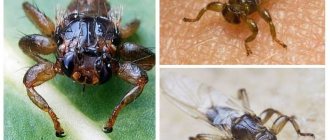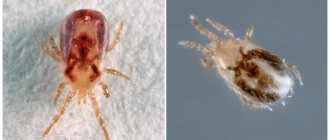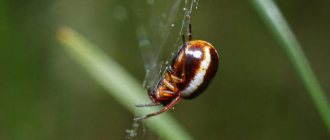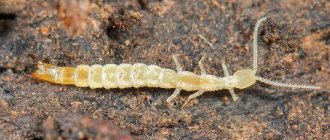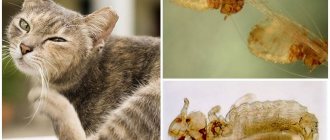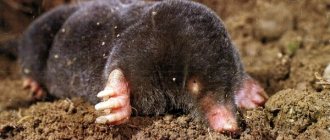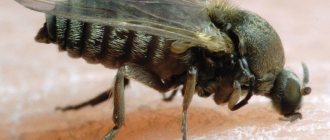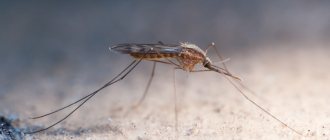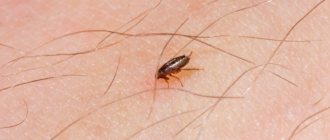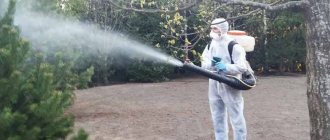Red mites are a family of mites from the order Acariformes. This is a large group of small arthropods, which got their name from the bright red integument of the larvae, the color of which intensifies when they are saturated with blood.
Red mites are characterized by a rather complex development cycle: adults and active nymphs are free-living predators that live in the soil and feed on various invertebrates, while their larvae are typical parasites that feed on the hemolymph of spiders and insects, and sometimes also on the blood of vertebrates. By the nature of their feeding, the larvae of red beetles are somewhat similar to ixodid ticks (for example, the taiga tick), and they do not have any selectivity in relation to host hosts - the larvae, during periods of their activation, are capable of en masse attacking arthropods, mammals, birds, reptiles and amphibians.
Some species are capable of attacking humans, feeding on blood and products of dissolution of integumentary tissues. The bites of such red mites are dangerous and unpleasant; they cause a special form of skin lesions (thrombidiasis). Red beetles also carry pathogens of a dangerous natural focal disease - tsutsugamushi fever.
On a note
Unlike ixodid ticks, red ticks, fortunately, do not carry tick-borne encephalitis and Lyme disease (borreliosis). However, tsutsugamushi fever is no less dangerous - if left untreated, the mortality rate reaches 40%.
We will talk further about where red mites live, what are the features of their development, nutrition and reproduction, as well as how to protect yourself from their bites...
Red tick: photo
The first and most important thing that will help you determine the type of tick found is its appearance. What does a red beetle look like?
- The body length of an adult red tick can reach 4 millimeters in length.
- The color of the tick is rich, bright, red, somewhat reminiscent of the color of a tomato.
- Everything is painted a uniform tomato color - the body, head, legs.
- The body is covered with countless fine, soft hairs, which is why the pest is often called the red velvet mite.
- Like all arachnids, the insect has 8 legs.
- Red mite larvae look like adults but are smaller, look like bright red dots, and have 6 legs instead of 8.
To finally make sure that it is a red mite in front of you, a photo of the insect will help.
Red Heifer
It lives in the soil and is often found in garden plots. Does not harm plants, is not dangerous for humans. It feeds on insects and their eggs. The red-backed mite looks more like a plush spider. The second name is velvet mite. The body size of the female reaches 15 mm. Long thin limbs. The entire body is covered with short soft hairs. A photo of a red tick with an unusual appearance is presented below.
Red beetles live among wild nature; they love forests, edges, and meadows. They do not pose a danger to humans, but they can bite if their own life is threatened. A red spot, swelling, induration, and slight itching remain at the site of the lesion. The condition returns to normal within a few days.
In total, 300 species of red beetles are known, 30 live in our area. Adults and eggs overwinter in the ground. Over the summer, 1-2 generations grow.
The red-bottomed, velvet-covered tick is widely used in Indian folk medicine. Arachnid oil has the property of increasing sexual desire, prolonging sexual intercourse, and improving potency in men. Used as natural Viagra.
Prevention
To prevent the disease in epidemiological regions, vaccinations against encephalitis are given to the local population, guests, and specialists staying there for work. To avoid a tick bite, follow certain rules:
- in the forest they wear clothes made of thick fabric with cuffs and drawstrings;
- be sure to wear socks and a hat;
- you need to examine the body every 2 hours, carefully after returning home;
- things are immediately thrown into the wash;
- To repel pests, repellents are used - Taiga, Off, Raptor, Raid, etc., essential oils;
- If you frequently stay in the forest, it is recommended to wear special suits with traps impregnated with insecticidal substances.
Chemicals are used to bait ticks in the forest, garden, country house, and garden plot.
Where and how do red ticks live?
Identifying red ticks can be helped not only by their very bright appearance, but also by some features of their life activity.
- Red beetles live in the top layer of soil.
- They crawl out of the ground in large numbers after rain.
- They can live in sand, black soil, forest floor, moss and loamy soils.
- Adult velvet mites do not eat constantly; they feed only once a year for just a few hours before breeding.
- The larvae eat continuously until they develop into adults.
- Ticks are active during the day, prefer soils heated by the sun, and do not appear on the surface at night.
The red beetle looks like a small bright red bug, spider or mite. Color is one of its main distinguishing features. In nature, any bright and contrasting color of insects is always a danger signal for those who may feed on them. The data available to date confirms that red beetles indeed have very few natural enemies. Scientists suggest that the problem lies in special toxins contained in the tick’s body. It is their presence that is indicated by the color of the pest.
What is a red tick
This pest appeared in our country from a hot climate, where it lived in the wild. In our climate, it has taken root in greenhouses, greenhouses and greenhouses. The number of plants that this creature has chosen is more than 65. Under normal conditions, the tick feeds on the juices of bananas and lemons, orchids and papaya. In some countries, he prefers tea and various citrus fruits. On a plant, it eats up 1-2 mm of the area around itself; in general, a colony of mites spoils entire trunks of trees, bushes, and flower crops. The colony consists of 99% females. They lay eggs directly on the leaves. Caterpillars emerge from the eggs and soon turn into adults.
An adult tick has a small, round body. Small bristles of yellow, brown, and sometimes green color are visible on it. There may be small spots on the sides of the body. Males differ from females in having a more elongated body shape and smaller size. Red mites reproduce by laying eggs. They are whitish in color and are deposited on plant leaves. Gradually they become cloudier and acquire a yellow color. Under favorable conditions, eggs mature within 15 days. Favorable conditions are ambient temperature +15°C. At +30°C the larvae can hatch in 2-3 days. The fertilized eggs will hatch into females and the rest into males.
The hatched larva has 3 pairs of legs. After molting, another pair appears. The lifespan of a generation of ticks is 7-36 days. This depends on the ambient temperature. Mites damage approximately 200 species of different plants. The size of the pest is very small - from 0.4 to 1.0 mm. Less often they grow to 2.0 mm. They harm flowers growing in greenhouses, garden cucumbers, and other plants. They only do not damage algae. The red mite is a polyphagous species. It is able to eat plant and animal food. The main place in his daily diet is occupied by the juice of plants, which gradually begin to hurt and become entangled in cobwebs. Soon a whole colony of mites appears on the web (photo No. 2).
Arachnoid
The little red mite is a dangerous plant pest. Prefers roses, hawthorn, pear, apple, citrus fruits, seedlings, cucumbers in the greenhouse, as well as indoor flowers, especially orchids. It is problematic to notice one individual, since the maximum size of the pest is 0.5 mm. The red mite becomes noticeable when it spreads en masse through a tree, bush, or flower.
The spider mite settles on the bottom of the leaf and sucks out the juices. Gradually it affects the entire culture. Signs:
- dark, light spots on the plate;
- leaf curling, drying, dying;
- falling of flowers;
- slower growth and fruit formation;
- decrease in yield;
- the presence of cobwebs.
A humid climate, temperature within 22 degrees Celsius, promotes reproduction.
On a note!
The red spider mite has excellent adaptability. When temperatures drop, it burrows into the ground and goes into suspended animation. It can remain in this state for six months; when conditions return to normal, it resumes normal life activities.
How do red mites reproduce?
Like all mites, red mites are oviparous insects.
- The active breeding season can occur between March and July, the exact dates depending on local weather and general climatic conditions of the current season.
- Repeated oviposition can occur in the fall, but in the middle zone this does not happen every year.
- If the laying was done in the fall, but the larvae did not have time to complete their development, they can overwinter in the soil under the cover of snow and continue growing in the spring, after the sun warms the ground again.
- Each clutch can contain from several hundred to several thousand eggs.
- The incubation period of eggs takes from 1 to 2 months.
- After hatching, the larvae begin to parasitize insects; the stage lasts 1–2 weeks.
- After turning into an adult insect, red mites repeat the entire reproduction cycle again.
Larvae are the most voracious stage of parasite development.
Life cycle features
The life cycle of red mites consists of seven stages:
- egg;
- prelarva;
- larva;
- protonymph;
- deutonymph;
- tritonymph;
- adult (imago).
Experts note that in the conditions of the south-west of Russia, red mites have 1-2 generations per year, and in the natural environment there are simultaneously individuals of different ages.
The larva, deutonymph and adult are the active stages, while the prelarval, proto- and tritonymph stages of the red beetle are dormant.
On a note
Initially, it was believed that during the resting stages of the red mite larvae, complex histological processes develop inside, characterized by the dissolution of tissues and organs and the return of the body, as it were, to the state of the embryo. However, recent research has made it possible to associate these changes with a special form of molting, which represents a separate phase of individual development. The beginning of the resting stages is now considered immobilization, and the end is the beginning of active movements.
The habitat for all stages of ontogenesis of red mites is soil. Only the larva leaves it for the feeding period. The female and the male meet in the soil, fertilization is spermatophore (a spermatophore is a sac with seminal fluid). The female picks up this sac with her genital valves, and fertilization occurs.
After some time, eggs are laid. The eggs are located in soil cells in groups, and prelarvae form in them. The prelarvae give rise to larvae, which are blood-sucking external parasites that are not characterized by selectivity in choosing a host.
The larva feeds on the tissue fluid of insects, spiders, and vertebrates and stays on them only during the feeding period. Typically, the larvae accumulate on the soil surface, lying in wait for the host, and actively attack it when approaching.
The duration of feeding on the host depends on the type of tick and can range from 3-5 to 10-32 days. A well-fed larva leaves the host and returns to the soil - but it may end up at a considerable distance from the place where it originally attached itself.
Afterwards, the larva goes into the soil and sequentially goes through all three nymphal stages. Deutonymphs and adults are active soil predators that feed on small invertebrates and their eggs (mainly springtails).
Thus, the connection between red mites and their hosts is determined, firstly, by their use of the latter as food items, and secondly, as a means of dispersal. These points, apparently, determined the characteristics of parasitism in red mites, which we will talk about below.
Preventive measures to combat insects
How to get rid of red mite? This question should concern gardeners, as well as lovers of indoor plants, since their favorite location is the back of the leaves.
The following can be used as preventive measures:
- Several times a week, wipe the leaves of the plants with a damp cloth and spray them with chemicals to kill pests.
- When the room humidity is low, especially during cold weather, you need to regularly inspect the leaves of plants, since mite larvae love dry air.
- Monitor the condition of the soil in which the plant is located and, if necessary, spray the soil with special antiseptics.
Red tick: is it dangerous?
Many justifiably associate ticks with blood-sucking parasites, although in nature there are a colossal number of species that do not consider humans or other warm-blooded creatures as a source of food. How does the red tick behave in this regard and is it dangerous?
As is the case with other ticks, the degree of danger of red mites is entirely based on their diet.
- Red mites feed mainly on insects smaller than themselves, their eggs and larvae.
- Cannibalism is common among red beetles.
- The larvae of velvet mites are especially voracious; in a day they absorb twice as much food, and sometimes three times as much as an adult insect.
- Ticks feed on body fluids and tissues, not specifically blood, although physiologically they can absorb and digest it.
Thus, red mites are not blood-sucking parasites, but they are carnivores, which means they have a predisposition to feed on living organisms. Is it dangerous for humans and pets?
Is the velvet mite dangerous for humans?
The red tick is dangerous to humans and animals only in the fall at the larval stage. She is very aggressive and attacks people. This can also be fraught with serious diseases, for example, skin dermatitis or thrombidiosis.
In rare cases, the red beetle tick can cause a dangerous natural focal disease - tsutsugamushi fever, scrub typhus, Japanese river fever. These diseases lead to death in 30% of cases.
However, many experts believe that fears about the little red tick are greatly exaggerated. Much more harm is caused by chemicals and insecticides used to combat these insects.
Signs of infection
This parasite has a red butt on the underside of the leaves, but it cannot be seen due to its very small size. Also, we will not be able to examine the damage that appears on the leaves after a bite. But the consequences of its presence on the flower have obvious signs.
Proof of its presence are small brown spots on the leaves. When their colony is large enough, a few spots are not enough; large affected areas and spots appear. These are the consequences of the bites, but as the juice is sucked out of the leaf, its yellowing is noticeable, the plant weakens and, as a result, the leaves fall off.
Another telltale sign is the presence of cobwebs. It envelops the space between the stem and leaf. The more insects there are, the more webs, large populations, are able to completely envelop the flower.
The damage it does
Before we talk about how to get rid of red mites, it is worth describing the damage this insect causes to garden and indoor vegetation.
Damage caused by red mite on some plants
Basically it comes down to the following criteria:
- Settling on the leaves, plant pests suck out their juice.
- Due to lack of juice, water balance is disrupted.
- Chlorophyll levels are significantly reduced.
- Photosynthesis stops completely.
- The plant weakens against the background of ongoing negative processes.
- If red mites move to garden trees, the fruits on them develop small or even die. For trees, spider mite parasitism is dangerous at any stage of development, both at the time of growth and when the crop appears.
The proliferation of spider mites in the garden is associated with the incorrect and irrational use of fertilizers containing large amounts of phosphorus. They provoke the death of those animals and birds that could prevent the spread of parasites called spider mites in the garden. In some cases, the increase in the number of mites is due to the presence of a stimulating effect on the insect body of certain types of drugs, provoking a significant increase in its fertility. In addition, mites appear in large numbers on plants when populations arise that are resistant to popular types of insecticides. It should also be noted that not all varieties of red mite are capable of forming populations resistant to chemical insecticides. For example, the brown fruit mite cannot form populations resistant to acaricidal drugs. And therefore, it is often replaced in the garden by red fruit and hawthorn mites.
Why is the red tick dangerous for humans?
According to official scientific data, the red tick is not dangerous to humans. We are talking specifically about ordinary red mites, and not about all representatives of acariform mites or red mites. People and domestic animals are not the mainstay of the common red beetle's diet; the tick does not depend on them for food, and accordingly, there are no official statistics on common red beetle bites. However, hypothetically, as an exception, since there is no official data on this matter, red beetles and especially their larvae, due to indiscriminateness, can bite a person, although the likelihood of this event is negligible. In this case, you will receive maximum skin irritation and a fleeting local allergic reaction, and the bite site will heal in a matter of days. If a tick of a shade close to red has attached itself to the skin, most likely it is some kind of tick from the ixodid family
.
Reproduction of red beetles
Formed red mites are characterized by weakly expressed sexual dimorphism. This type of mite is distinguished by a very complex form of metamorphosis. It was the result of the fact that some phases of development perform the function of nutrition, while others completely cease to feed. They have turned into a kind of formative resting phases and in this way resemble an insect pupa.
Unlike insects, which have a single pupa, red beetles are characterized by an alternation of morphogenesis and feeding phases. Eggs that are laid in the soil layer hatch into a motionless prelarval form. Then, consuming the yolk reserve from the intestines, it turns into a larva.
Red mites are characterized by similarity in the external genitalia of both sexes. Spermatophore fertilization without copulation was preserved. The reproductive apparatus is equipped with a lid, a protruding cone, and three pairs of genital tentacles.
Coloring and external structure
Since it is the larvae of red beetles that are active parasites that pose a certain danger to humans, the description of many species is based precisely on the morphological features of the larvae.
On a note
For many species of red beetles, the imago (adult) is not even described, since it is not so easy to detect an adult in the soil. In addition, given the diverse structure within the same species (polymorphism), it is extremely difficult, and in some cases impossible, to compare an adult soil inhabitant and a blood-sucking larva. To compile a complete development cycle and describe each stage, scientists need to catch larvae in nature and breed red calfs in the laboratory. This is a complex and painstaking task, which does not always end in success. That is why red mites are considered one of the least studied among ticks.
As noted above, the stage of the red mite life cycle at which it is dangerous to humans is the larval stage.
The larvae of some species of red beetles are very small, they are not always easy to see with the naked eye: the body length of hungry individuals is approximately 300 microns, and that of well-fed ones is 600-800 microns.
The body of the larva is not divided into segments and has the appearance of a bag. In hungry individuals, the integument is collected in folds, which, when the tick is saturated, straighten out, thereby increasing the possible volume of absorbed hemolymph or blood.
The top of the red mite is covered with bristles and hairs (trichobothria). Their number and placement on the body is strictly defined and is species-specific. The dense arrangement of bristles and numerous folds on the body of the larva look like velvet, which is why the red beetle is also called the “red velvet mite” (see photo below):
In general, the color of the integument can be very diverse:
- with a bright red back;
- dark red color;
- in addition, the tick may have a reddish abdomen and a dot on it.
The intensity of the color depends on how saturated the tick is. The color of the blood that the red beetle has sucked is visible through the translucent integument of the body, so a well-fed larva is more intensely colored than its hungry relatives.
On the dorsal side, the tick's body is covered with a scute (a dense, wide chitinous formation). It usually contains two long bristles - sensilla. They perform the function of touch and help the small parasite find its future victim. It is the sensilla and other trichobothria, located in different parts of the body of red mites, that perform the main sensitive function.
On a note
All the bristles of red mites are located at a certain angle to the body, which reduces resistance when moving and increases the maneuverability of the parasite. In addition, the tick is flat, and together all these factors contribute to the fact that red beetles can move very quickly along the surface of the host’s body among the fur and hair, while firmly clinging to individual hairs if necessary.
At the base of the shield there is a pair of primitive eyes - they react only to lighting, and the parasite only senses changes in the light/dark gradient.
It is also useful to read: Ear mites in humans and animals
Larvae, unlike nymphs and adults, have not 4, but only 3 pairs of walking legs, so they can be confused with some small reddish bug.
The legs of red ticks are segmented, consist of seven sections and end with sharp claws, with the help of which the parasite clings to the fur or clothing of the future host.
On the abdomen there is a slit-like anal opening (excretory pore). There is no genital opening.
On a note
The coloring of red beetles does not play a primary role in identifying these parasites. There are many red insects that look like mite larvae. Moreover, it will not be easy for an unprepared person to make such an identification - any small bug with a red bottom (abdomen) may appear visually similar to a red beetle larva.
Moreover, a number of tick species have a reddish tint, but do not belong to the Trombiculidae family. For example, if you notice a reddish mite on an apple tree that grows in the area, or on an orchid or lemon in the room, then most likely it is not a red mite, but a spider mite. This is a completely different systematic group of parasites: they feed on plant sap and pose absolutely no danger to humans.
Among red beetles there is no division, for example, into citrus or apple mites, but they may well live in the garden on the ground. If you notice a small velvety red tick on a cat, then there is a high probability that it is a red mite.
Red tick in dogs
Dogs, just like people, are not food for red ticks. Insects do not specifically attack them and do not stick to them in large numbers, so red ticks in dogs are mostly a myth. At the same time, insects may end up in a dog’s fur simply because the dog was lying on the ground, and the larvae may try to bite because they cannot discern whether the food in front of them is suitable or not. Such bites are not dangerous to animals and are unlikely.
If you find red ticks attached to your dog, in the vast majority of cases these are one of the types of blood-sucking ticks. Tick bites are extremely dangerous for dogs, mainly due to tick-borne encephalitis, so as soon as you discover a parasite on your pet or notice any alarming symptoms in his behavior or appearance, contact your veterinarian immediately. This must be done even if you pulled out the tick yourself. Author of the article Myagkov Sergey
What does a red mite look like?
Such insects are easy to distinguish from other ticks by the bright color of their bodies, made in red-orange tones. The body size of an adult insect (imago) is 4 mm, and female individuals always have a larger size.
Larvae differ from adults only in size and number of legs. If the imago has four pairs of legs, then the larva has one pair less. The tick's head is very small, and its body and legs are completely covered with short, thick hair. That's why this type of tick is called a velvet tick.
The larvae hatching from the egg are very small. Their size barely reaches 500 microns. Having fed, the larva increases in size, its chitinous shell stretches and becomes rounded. Its color depends on the degree of satiety of the insect. Ticks that are engorged with blood are purple in color, while hungry ones are orange.
These small red mites have made their presence known on all continents, with the exception of Antarctica. They adapt well to any conditions and can live in forests, steppes, vegetable gardens, orchards and meadows. They have a particular preference for moist environments.
Destruction methods
There are many ways to combat the red flat mite and here are some of them.
Non-chemical methods
An abundance of host plants, a warm, humid climate and few natural enemies provide favorable conditions for high population densities of this mite. Therefore, creating conditions contrary to this does not support active reproduction of the pest. The best option for combating red mites, which is accepted in greenhouse conditions, is to lower the temperature as much as possible so that it does not harm the plants and is not economically expensive.
Biological control
At least four predators of the red flat mite are known. These include three larger ticks and one beetle:
- Phytoseiulus macropilis.
- Amblyseius largoensis (Muma).
- Mexecheles hawaiiensis (Baker).
- Sticholotis beetle.
Predatory mites, P. macropilis and A. largoensis feed on red mite eggs but do not attack other life stages of the pest. Larvae, nymphs and adults of M. hawaiiensis attack all active stages of the red flat mite. As for the sticholothis beetle, it is used to control the scale of the red mite in China and Japan, where the pest is also very numerous. The bug loves to feast on all stages of the pest, and it does absolutely no harm to plants.
The predators mentioned above generally do not provide economic control, since their predation only becomes apparent when the prey population density is very high. Therefore, this type of struggle is relevant only on an industrial scale.
Sticholotis beetle - enemy of red mites
Chemical control
Because this mite reproduces parthenogenetically, like most other false spider mites, they do not have the genetic variation that occurs when mixing with most species of mites that reproduce sexually. Thus, pesticide resistance is less likely and less of a problem. Despite this, the red flat mite is resistant to certain organophosphates and is susceptible to most acaricides. In addition, resistance may develop if pesticide use has been very frequent.
Chemical sprays should be applied to affected plants at 2-3 week intervals if the infestation is severe. Any of the registered acaricides is usually effective. But sulfur should not be used in places where the relative humidity is abnormally low.
Treatment
Birch tar is used to treat chicken acariform mites on the legs of poultry. It is heated to a temperature of 40 degrees, poured into a deep bath and the chicken is placed in the solution up to the hock joint. You can simply treat the parasite-affected surface of the leg with tar, using a soft brush, at intervals of 6–7 days.
Advice! If the mite lives on the legs of chickens, use a solution of Trichlorometaphos or a mixture of birch tar and kerosene in a 1:1 ratio.
If chickens are infected with scabies mites that live on their legs, the parasites can be removed using acaricidal-insecticidal agents of complex action in drops, solutions, and aerosols. They are simply rubbed into the affected skin several times at intervals of 2-3 days.
Let's sum it up
In some cases, the mite can cause mass mortality of poultry, so farmers, regardless of the method of keeping chickens, should not exclude this possibility. It is better to carry out preventive treatment first and protect individuals from parasites.
Video - Process of treating chickens for parasites
Nikolay Zhuravlev chief editor
Author of publication November 22, 2018
Did you like the article? Save so you don't lose!
Chicken mites cause a lot of problems not only for the birds themselves, but also for farmers and poultry farmers. In the event of infection with a dangerous ectoparasite, laying hens' productivity decreases and the condition of their feathers deteriorates. Chickens and young broiler breeds infested with feather mites lag behind in growth and development compared to their healthy peers and slowly gain weight. Despite the fact that parasitic mites are most active in the warm season, birds can become infected in any season. How dangerous are chicken mites? How to fight and completely get rid of chicken mites?
Why does a spider crawl in bed, on a bed, on a pillow: a sign
- On the hand - a generally positive sign.
- On the left hand - to wasteful spending.
- On the right hand - extra money will appear.
- Crawling along your arm or shoulder - soon you will meet an old acquaintance or receive a message from him.
- Sat on your hand - also a positive meaning.
- Crawling up your hand - your loved ones or friends want something from you.
- On your face - something good awaits you in the near future.
- Came down from the ceiling in front of your face - a positive sign. Your business portends success for you, you will be prosperous.
- Slowly spinning a web in front of your face is also positive.
- On your feet - to new acquisitions.
- Crawling up the leg - to large purchases.
- Crawling over a person’s body - to monetary rewards.
- Why is he running all over me? Perhaps they will give you a bonus.
- Sits on the body - soon there will be financial well-being if you don’t give up.
- On the neck - perhaps your loved ones will help or please you with something.
- On your hair - expect guests. Hair is associated with cobwebs, so the sign is favorable.
- Crawling up clothes - you will buy yourself new clothes or personal items.
- On shoes - you will have to lose something or spend a lot of money.
- In a circle - you have an envious person.
- A spider crawls up your body - the business you are doing will bring you success, harmony and prosperity.
- A spider is crawling down your body - most likely, you will soon experience minor financial difficulties.
- A spider crawls along your right hand - a good job with sufficient income will come your way.
- A spider crawls along your left hand - do not lend money, it may not come back to you.
- A spider crawls along your right leg - a person you will meet soon can give you wealth and prosperity.
- A spider crawls along your left leg - due to quarrels and damaged relationships with loved ones, you risk losing your income.
- A spider crawls across your chest - your health is not in the best condition.
- A spider crawling on your head - a sign foretells pleasant changes for you in the near future, perhaps a meeting with a good person or news.
- A spider crawls along your right shoulder - you risk doing the wrong thing.
- A spider crawls along your left shoulder - extra spending can ruin you.
Spider and signs associated with it
Signs and interpretation:
- The spider crawls across the floor to the left - do not borrow money from anyone in the near future, it may not come back to you.
- A spider crawls across the floor to the right - most likely, your debt will soon be returned or someone will be able to help you financially.
- A spider crawling across the floor towards you means pleasant changes in life, good news.
- A spider crawls across the floor away from you - protect yourself from waste and communication with unpleasant people.
- A spider crawling along the ceiling to the right is a good omen, you will be in abundance, your expenses will not ruin you. The profit will be much greater.
- A spider crawls along the ceiling to the left - a sign that your financial situation will be quite good, but you should still protect yourself from unnecessary waste.
- A spider descending from the ceiling is a bad omen, foreshadowing a financial “hole”: debts, loans, ruin.
- A spider on the wall is a good omen, which tells you that your financial situation will improve in the near future.
- A spider crawling down the wall portends spending, wasting money, problems with debts and losses in gambling.
- A spider crawling along the wall to the right means that you will be able to get good benefits from odd jobs.
- A spider crawls along the wall to the left - a little financial help from loved ones.
Correct interpretation of signs with spiders
- A spider descended on your head - a favorable meeting with a good person, prosperity and well-being.
- A spider descended on your hand - soon you will be lucky enough to find a source of additional income.
- A spider descended on your hair - you will receive good news or you will meet a significant person.
- A spider has descended on your face (nose, eye, mouth) - take care of yourself from diseases, “bad” people with the “evil eye”.
- A spider descended in front of your face is a good omen that portends many pleasant events in your life.
- A spider on the bed means betrayal by one of the spouses or possible deception on the part of a loved one.
- A spider on the wall near the bed means that one of the spouses has a rival.
- A spider crawled out from under the bed - deception and betrayal of one of the spouses, a loved one.
- Spider on the pillow - male infidelity
- A spider on the ceiling above the bed - quarrels, problems and scandals caused by the betrayal of spouses.
The spider and the signs it brings
Types of flat beetles
There are many types of spider mites, but the most common are:
- Regular - size may vary depending on its fatness. Color - from orange to bright red. Damages about two hundred species of plants.
- Red spider - sizes can vary from one tenth of a millimeter to 2 mm. Color – all shades of red. Damages plants indoors.
- Red-legged spider - threatens many ornamental plants. The body is most often orange.
- Atlantic spider - widespread everywhere. It primarily damages cucumbers.
Diet of red mites
The host range of red mites is unusually wide. In general, this group is not characterized by any selectivity in choosing a future feeder. However, the range of possible hosts narrows depending on the habitat in which the tick lives.
If this is a steppe species, then, in addition to invertebrates, small mouse-like rodents can be feeders. Wood mites usually have more choice, and trophic relationships also extend to larger mammals.
Studies of the fauna of Trombiculidae have shown that a large number of species of red beetles feed on rodents, less often satiation occurs on insectivores (hedgehogs and moles). This is followed by the parasitic fauna of chiropterans, birds and reptiles.
Humans, like primates, appear to be occasional hosts - however, many red beetles are capable of attacking humans and sucking their blood.
After hatching, the larvae are active, crawling out of the soil and climbing into the upper layers of leaf litter or onto herbaceous vegetation. During this period, they are characterized by positive phototropism, that is, ticks strive for light, but at the same time avoid open areas illuminated by direct sunlight.
After some time, they slide down, forming extensive aggregations, so red beetle bites are often widespread. In their shelters, red beetles await potential prey.
When it comes into contact with it, the red tick's chemoreceptors are activated, and the parasite begins to move quickly, actively selecting places for attachment. This process is much faster than, for example, with the black forest tick.
It is also useful to read: About the taiga tick and the danger of its bites for humans
If the owner is a warm-blooded animal, red beetles choose areas of skin with thin integuments and a high degree of blood supply, as well as inaccessible for scratching and shaking off. In animals it is mainly:
- scruff;
- ears;
- nose;
- area around the eyes;
- groin area;
- genitals;
- anus and perianal area.
In some species, the larvae may not look red, but yellowish:
In humans, bites are primarily exposed to open areas and limbs . The duration of feeding of the larvae depends on the species and can last from several hours to two days. After saturation, the larva falls off and begins to actively migrate into the soil, where it passes into the protonymph stage. Hungry larvae do not survive the winter and mostly die.
The nature and feeding habits of the red tick are determined by the structure of its oral apparatus, which is called the gnathosoma (that is, this is the entire anterior part of the body). The gnathosoma consists of 2 pairs of limbs: two-segmented chelicerae and five-segmented pedipalps. At the same time, the chelicerae are not enclosed in any protective chambers, which is the main feature of all Acariform mites.
The head section is clearly separated from the body by a constriction, around which a specific ridge is formed that performs a number of functions. Firstly, when attaching a tick to the host’s body, the roller plays the role of a suction cup, thanks to which the parasite is securely attached to the victim. Secondly, such a mechanism facilitates the suction of liquid - due to the vacuum action.
On a note
The absorption of hemolymph or blood into the narrow pharynx of the parasite is carried out mainly due to contractile movements of the esophagus. When the muscular walls of the pharynx are compressed and relaxed, negative pressure is created, and the liquid rises along the conducting pathways. The skin sucker, in turn, enhances the pumping effect.
Chelicerae look like thin and sharp scalpels. With the outer side of the chelicerae, the mite cuts the integument of the victim, while their internal parts create a chute through which food moves into the digestive tract of the red beetle. The palps perform a sensitive function due to the bristles located on them. They do not take part in the attachment or feeding of the larva, so it clings with only 6 walking legs.
When parasitized by red beetle larvae, a special food tube is formed, called a stylostome - due to its formation, the host tissues are affected much more severely than when parasitized by ixodid ticks. This is one of the dangers of encountering red mites.
The stylostome is a derivative product of the activity of the salivary glands and is a thin tube that penetrates deeply into the host tissue. As the larvae feeds, the stylostome increases in length, which allows deep penetration into the integument with short mouthparts.
On a note
A developed stylostome perforates the epidermis, but never reaches the dermis. At the end of the stylostome, an accumulation of saliva forms and a focus of inflammation occurs. Blood elements, dead leukocytes and tissue lysis products of the upper layers of the skin accumulate in the lesion. The longer the tick feeds, the more pronounced the inflammatory reaction becomes. The red beetle drinks not only blood - in addition to it, the main part of the nutritional substrate consists of the lysed tissues of the victim, therefore the bites of the red beetle are more painful than the bites of encephalitis ticks.
In addition to external parasitism, red beetle larvae, depending on the species, can live in the respiratory tract of mammals and birds, and can also develop subcutaneous parasitism.
Now let's talk about the types of parasitism within the group of red beetles and what a person should be afraid of first of all...
Most likely routes of spread
The pest has one peculiarity - it is practically impossible to infect plants from the street with it, since it cannot stay outside its place of residence for a long time. Healthy plants become infected only from sick relatives through their introduction. Since the bite is completely invisible, this becomes the main reason for the proliferation of red mites. That is why each new plant should be carefully examined using magnifying devices.
Mites suck out quite a lot of leaf cells, which leads to a decrease in the process of photosynthesis. The plant weakens greatly and becomes easy prey for many diseases and other pests. This means that the death of plants does not occur as a result of direct small bites, but rather from their consequences, since they provoke an outbreak of other diseases that are more dangerous for the flora.
Infection and spread
The fact is that this insect can appear on a crop only due to infection from another plant. They cannot travel long distances and remain outside the plant for a long time. If, for example, there are a small number of them on a flower, then you will not be able to notice a pest with a red back. Therefore, an infected flower can easily get to healthy ones and then population reproduction cannot be avoided. To avoid such situations, magnifying devices are used that allow the parasite to be examined.
Since their bites cause photosynthesis to decrease, crops become very weak. In turn, this leads to the fact that crops begin to suffer from various diseases that are very dangerous for the flora.
Use in folk medicine
The hemolymph of the red mite has a fairly powerful fungicidal effect. In this regard, it is widely used in folk medicine of the people of India. It is used to prevent paralysis, and also as an aphrodisiac: it is believed that the oil obtained from red beetles increases sexual desire. In modern medicine, this issue is still at the stage of consideration. Scientists are just looking at these arthropods as a potential source of immunomodulators.
Source
